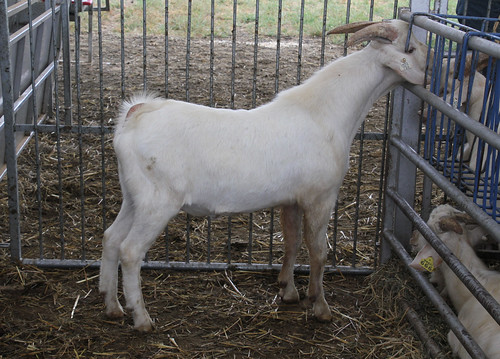Scrotal circumference (SC) is a highly heritable trait. It was measured using a scrotal tape. In the test bucks, it ranged from 17.5 to 27.5 cm and averaged 22.6 ± 2.1 cm. The median SC was 23 cm. The buck with largest scrotal circumference was 649 (Murphy, NJ). It was a top 10 buck.
 |
| USDA Selection 1 |
Minimums for scrotal circumference have not been determined for meat goats. In the absence of standards, producers are encouraged to select bucks with larger testicles. Weight is the biggest determinant of scrotal size. Nutrition also has a large effect.
Teat structure is heritable. All but two bucks had a sound teat structure and two teats. Two bucks had supernumerary teats, including cluster teats. Supernumerary teats are associated with teat abnormalities. Two teats is the norm and the preference for meat goats.
Jaw defects are heritable. No buck had a severe jaw abnormality. A few bucks had slight over or underbites. Goats, especially bucks, with severe defects should be culled. An over or underbite of 1 to 3 mm is considered to be slight.
Hoof growth is heritable. Hoofs were examined to determine the degree of growth and any abnormalities. 0 denoted little to no hoof growth, whereas 5 designated severely overgrown hooves. Hoof growth ranged from 0 to 3 and averaged 1.1 ± 0.6. Only one goat displayed abnormal hoof growth (abnormal heel growth).
 |
| Good structure |
All of the bucks were evaluated for the structure: feet and legs, movement, etc. No buck was determined to be structurally unsound.
Each buck was assigned a USDA grade. The USDA grades for live goats are Selection 1, 2 and 3. 1 denotes a heavy muscled goat. 2 denotes a goat with average muscling. 3 denotes a goat with inferior muscling. An unthrifty goat is called a cull.
USDA grades ranged from 1 to 3 and averaged 2.25 ± 0.48. Quarter scores were used. Only one buck was determined to be USDA Selection 1: 639 (Loos, IL). It was a top 10 buck. Nutrition has a large effect on USDA grade. Pasture-raised goats tend to have higher (poorer) grades than fed goats.
Download Supplemental Data Report











